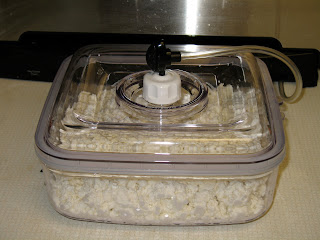 |
| Vet2Be on the left, AJ leading Janice on the right. |
He drank 1/2 gallon of goat's milk every day.
He told his mom he wanted goats.
He told me his mom said, "They aren't worth it."
I told AJ, "She's right."
Hmmm..... AJ wasn't sure what to think about that for a moment.
Goats cost money, so does their feed and housing, so do vet bills. Goats take time, especially milk goats. You have to be there to milk them, and you have to work with them and treat them like pets if you want them to be easy to milk on the stand.
So.... no, goats aren't worth the money.
But I told AJ that his computer isn't worth it, either. A computer doesn't pay for itself in what it produces. Neither does AJ's cat, Koda.
I asked him how much money Koda brings in. AJ answered, "I don't know. He doesn't share his money with me." Funny kid!
I was trying to tell AJ whatever hobby we choose to enjoy doesn't usually give a monetary return on the investment we put into it. If we pay for violin lessons for our kids, those lessons aren't going to 'bring in the money.' If we have a dog or a cat, they certainly don't give us something in return that would cost less at a store. The reward we receive is much different, and we believe, much greater.
For some reason people think that farm animals have to give back what we put into them. Our family came to the realization that we will never make any money raising goats or horses or sheep or anything else. We do it because we enjoy it, and because Vet2Be wants to be a veterinarian some day. We do it because it teaches him and the other children how to work, how to plan for the future, how to love somebody more than themselves, how to sacrifice something now for something you want in the future.
Around here most of the teenagers are interested in their cell phones, X-boxes, and their clothes. Very few think about next week, let alone next year, or 5 years from now. Most of them can't think outside the box. Most of them can tell you what is on TV tonight, but very few can tell you what the stars look like on a clear summer evening. Most of them have earbuds in and know the latest music, very few can tell you what it sounds like on a moonlit night out in the field. Often they think about the next minute, but they can't think something through. Most can't follow through unloading a dishwasher, let alone caring for an orphaned lamb. Patience and gentleness aren't usually in their vocabulary.
We didn't start farming and raising animals on purpose to teach our kids these things. The kids wanted the animals, and we jumped in for the ride. I am amazed at how much we have all learned about life by raising a few horses, goats, and sheep. I am surprised at the difference between our kids and the kids who attend the local high school. Our kids aren't perfect, not by any means! But they can often solve problems by thinking outside the box, and they can stick to a task, even an unpleasant one, until it is done. They have goals in life and know that the road to the goal isn't always pleasant and it isn't always easy, but it is worth it.
Is having a hobby farm worth it?
You bet! But it sure costs alot of time, money, hard work, heart-ache, and patience!
We consider it 'tuition costs' in the school of life.



























































